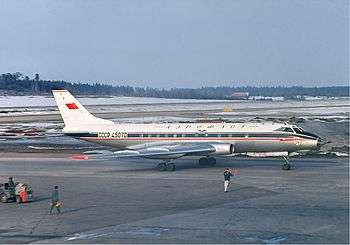1963 Aeroflot Tupolev Tu-124 Neva river ditching
|
A Tu-124 similar to the accident aircraft | |
| Accident summary | |
|---|---|
| Date | 21 August 1963 |
| Summary | Fuel exhaustion due to pilot and maintenance error |
| Site |
Neva river, Leningrad, Soviet Union 59°55′11″N 30°24′13″E / 59.91972°N 30.40361°E |
| Passengers | 45 |
| Crew | 7 |
| Fatalities | 0 |
| Survivors | 52 (all) |
| Aircraft type | Tupolev Tu-124 |
| Operator | Aeroflot |
| Registration | СССР-45021 |
| Flight origin | Tallinn-Ülemiste Airport, Estonia |
| Destination | Moskva-Vnukovo Airport, Russia |
The 1963 Aeroflot Tupolev Tu-124 Neva river ditching was a water landing by a Tupolev Tu-124 of the Soviet state airline Aeroflot (Moscow division). The aircraft took off from Tallinn-Ülemiste Airport (TLL) at 08:55 on 21 August with 45 passengers and 7 crew on board.[1] The aircraft (registration number SSSR-45021) was built in 1962[1] and was scheduled to fly to Moscow-Vnukovo (VKO) under the command of 27-year-old captain Victor Mostovoy. After takeoff the nose gear did not retract.[1] Ground control diverted the flight to Leningrad (LED) – because of fog at Tallinn.[1]
At 10:00 the aircraft started to circle the city at 450 m (1,480 ft), in order to use fuel, reducing weight and decreasing the risk of fire in the event of a crash. The ground services at Pulkovo Airport (LED) were preparing the dirt runway for the landing. Each circuit around the city took the aircraft approximately 15 minutes. During this time the crew attempted to force the nose gear to lock into the fully extended position by pushing it with a pole taken from the cloak closet.
On the eighth and last circuit while 20 km (12 mi) from the airport, the no. 1 engine flamed out due to fuel starvation.[2] The remaining engine ceased shortly thereafter, with the aircraft above the city center, traveling east over St. Isaac's Cathedral and the Admiralty. Upon loss of power the flight crew ditched the aircraft in the 300-metre (980 ft) wide Neva River.
Eyewitnesses saw the Tupolev descend upstream. Immediately after a turn, the aircraft glided over the high steel structures of the Bolsheokhtinsky Bridge with approximately 30 m (100 ft) of clearance. The Tu-124 flew over the Alexander Nevsky Bridge – under construction at the time – barely missing it. The pilot managed to land the aircraft onto the river, [1] in close proximity to an 1898-built steam tugboat.[3]
The plane began to flood.[3] The tugboat's captain then broke the aircraft's windshield to tie a cable to the cockpit's control wheel and proceeded to tow the craft to the river bank. During the tow all passengers remained on board. Passengers and crew then evacuated the cabin via an access hatch on the plane's roof.[3]
See also
Notes
- 1 2 3 4 5 Soviet Transports Team. "Soviet Transports Database". Scramble. Retrieved 19 January 2009.
C/n 2350701 ... rgd 11oct62
- ↑ "Воздушные гонки в Питере... 1:1 [RC Форум]" (in Russian). forum.rcdesign.ru. Archived from the original on 27 September 2007.
... circle the city at 1650 feet. ... aircraft was towed ashore.
- 1 2 3 "Pilot saves lives by landing on a river… in 1963". Russia Today TV. 16 January 2009. Retrieved 29 March 2011.
References
- "Prepare to Ditch", in Flight International magazine, 13 August 1964, p241
- "Soviet Transports" series, also Ditch or crash-land? B.W. Townshend, 1965 (pp 47–49)
- Accident description at the Aviation Safety Network
